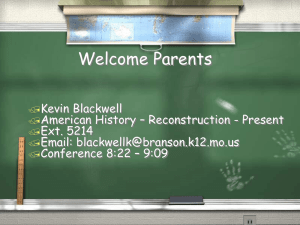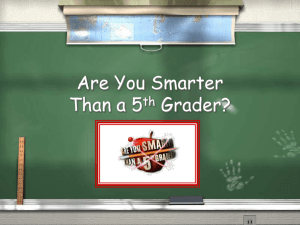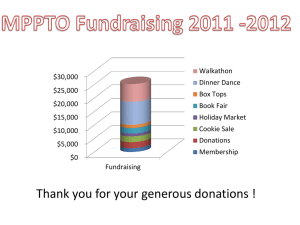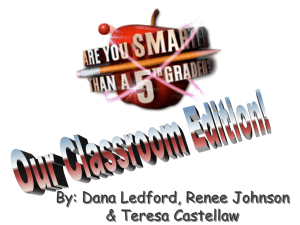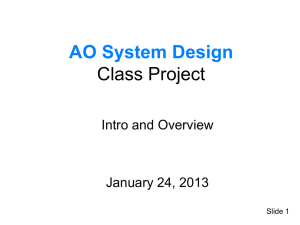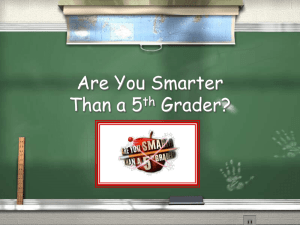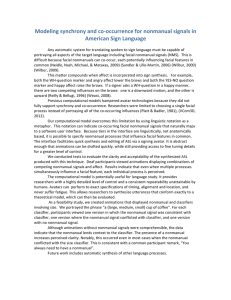Linguistics-5ed-p89
advertisement
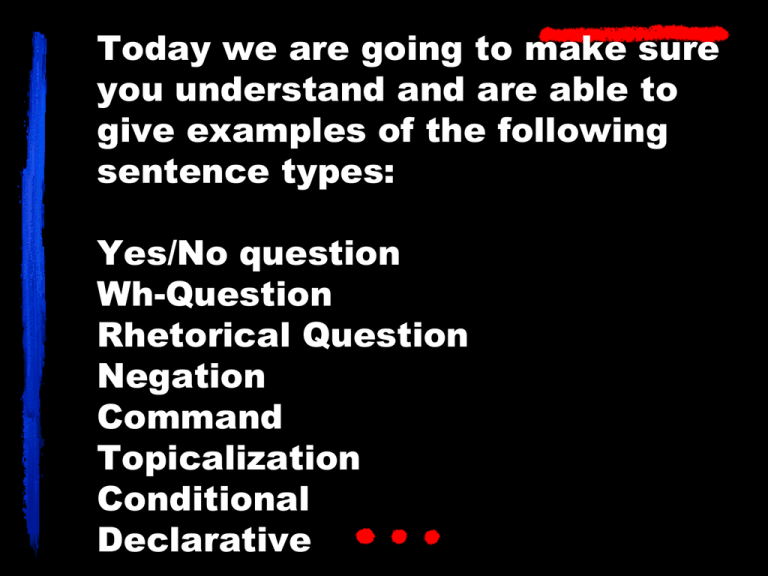
Today we are going to make sure you understand and are able to give examples of the following sentence types: Yes/No question Wh-Question Rhetorical Question Negation Command Topicalization Conditional Declarative Linguistics Syntax Pages 89 –98 th 5 Edition Warm up and Review: Question: What are the building blocks used in phonology? Answer: Individual features of signs. Question: What does "individual features of signs" mean? Answer: Handshape, Location, Orientation, Holds & Movements, NMM"s Question: What are the building blocks used in Morphology? Answer: "units of meaning" Question: (Review) List 5 ways to create or come up with new signs in ASL. [5th Edition pg 59] Derive nouns from verbs, (SIT to CHAIR) Compound two existing free morphemes, (THINK + MARRY = BELIEVE) Represent English orthographic symbols via special signs known as "fingerspelling" and then Lexicalize those signs, (#BACK or #JOB) Borrow a sign from another signed language, (ITALY-[newversion], CHINA[new-version]) Agentive Suffix: TEACHER LAWYER ACTOR Question: (Review) What is the difference between "derivational morphology" and "inflectional morphology?" [5th Ed, pgs 58-59] In "derivational morphology" we "derive" or "come up with or create" new "units" (words) for a language. [Think of "word classes": nouns, verbs, adjectives, etc.] In "inflectional morphology" we are not creating "new" units, rather we are tweaking existing units. We are adding grammatical information (such as "who did what to whom," "how long something went on," or "how many of something there are" – plurality, etc.). Question: The number of sentences that can be produced in a language is infinite. This is known as what characteristic of language? Answer: Productivity We have been looking at basic rules for word order. Now let’s consider some basic sentence types in ASL. 91 [5th Ed.] Now let’s consider some basic sentence types in ASL. Five basic sentence types tend to have very specific nonmanual features: questions negations commands topicalization conditionals declaratives 92 [5th Ed.] 127 th [4 Ed.] Yes-No Questions English = Voice rise up at end of sentence ASL Yes/no Questions eyebrows raise (may) tilt head (may) lean body forward (may) raise shoulders (may) hold last sign longer Page 128 (4th Ed.) 92 (5th Ed.) Note: The former symbol for glossing of Yes-No questions was a “q” on a line above the question phrase. (Old) _________q MAN HOME Lately we are using "y/n" instead: (New) _________y/n MAN HOME 5th Edition changes from th 4 Edition: Symbol for glossing of Yes-No questions is now a “y/n” on a line above the question phrase. _________y/n MAN HOME 92 [5th Ed.] 129 [4th Ed.] Question Mark \ Note: Used to be called "Question Mark Wiggle," now just called "Question Mark." Used to be glossed as QM-wg. Now just glossed as QUESTION-MARK. QUESTION-MARK: Tends to be used when signer is surprised or when something is unexpected. Compare to the English: (Really????) Also used when double checking or incredulous. Page 93 [5th Ed.] 128 (4th Ed.) Wh-questions Wh-questions tend to use signs like: Where / Who / When / What / Why Page 128 (4th Ed.) Page 93 (5th Ed.) Wh-question nonmanual marker: eyebrow squint (may) head tilt (may) lean slightly forward (may) hunch shoulders Example: ______wh MAN WHERE Page 129 (4th Ed.) Page 93 (5th Ed.) 129 [4th Ed.]94 [5th Ed.] Rhetorical Questions: Look like questions but the signer doesn’t expect an answer. Page 130 [4th Edition] page 94 [5th Ed.] Note: Rhetorical Questions The gloss for a rhetorical question used to be “rhet” but is now just "rh": Example: rh PRO.1 TIRED WHY STUDY ALL-NIGHT Common signs used for rhetorical questions include: REASON WHEN WHO WHAT WHERE FOR-FOR p. 130 4th Ed. p. 130 4th Ed. p. 94 [5th Ed.] Rhetorical Question nonmanual marker: Raised eyebrows Slight shake or tilt of the head Dr. Bill’s note: Think of a rhetorical as asking: “Do you want to know why?” “Do you want to know who?” “Do you want to know what for?” “Do you want to know where?” Those are actually yes/no questions and thus use a yesno nonmanual marker. Page 94 [5th Ed.] Page 130 [4th Ed.] Negation Page 131 [4th Ed.] Page 94 [5th Ed.] The process of changing an affirmative sentence to a negative is called negation. Nonmanual signals: shaking the head from side to side (may) frown (may) squint Gloss symbol: “neg” Example _______neg MAN HOME 95 [5th Ed.] 131 [4th Ed.] Commands: Also called “imperatives” English deletes the subject. Ex: “Sit down!” ASL Ex: *SIT* Commands: Nonmanual markers: Making direct eye contact (maybe) frowning Dr. Bill’s notes: Commands tend to modify the movements to be larger and the holds to be longer—especially at the end of the sign. 131 [4th Ed.] 95 [5th Ed.] Topicalization: Topicalization is when the object of the sentence is moved to the front of the sentence. Instead of signing: The father loves the child: “FATHER LOVE CHILD” You might sign: The child is loved by the father: “CHILD, FATHER LOVE” Topicalization NMMs: Raised eyebrows head tilt maybe short pause Example: HOMEWORK, PRO.1 DETEST 132 [4th Ed.] 96 [5th Ed.] Conditionals #IF SUPPOSE Conditionals: Nonmanual signal very important: * Raised eyebrows * Head tilt *( (maybe) short pause 127 Declarative sentences do not seem to be marked by any particular nonmanual signal as are other sentence types in ASL Example: ______________cond TOMORROW RAIN, GAME CANCEL 97 [5th Ed.] The Importance of Nonmanual Signals: Declarative: You are home. Yes-no question: Are you home? Negation: You aren't home. Command: Go home! Page 132 4th Ed. Page 97 5th Ed. th 5 See: Page 98, Ed. for a very nice summary of sentence types and accompanying nonmanual signals. Activity: Give me examples of the following sentence types: Yes/No question Wh-Question Rhetorical Question Negation Command Topicalization Conditional Declarative

